Near the Cauvery Underpass on Sankey Road is a majestic old Indian rubber fig tree, its aerial roots spread all around. With a height of 12 metres and a girth of 11 metres, the tree is a sight to behold, its huge canopy extending right across the two lanes.
A little ahead in the same street is yet another Indian rubber fig, towering over the Café Coffee Day outlet next to it. Both trees are believed to be 60 plus years old and are just two of the 50-odd trees that would have to be cut or lopped in the event of the four-lane flyover coming up on Sankey Road. The BBMP had floated tenders for the flyover construction without consulting residents, created a Detailed Project Report (DPR) and even marked the pavements on Sankey Road.
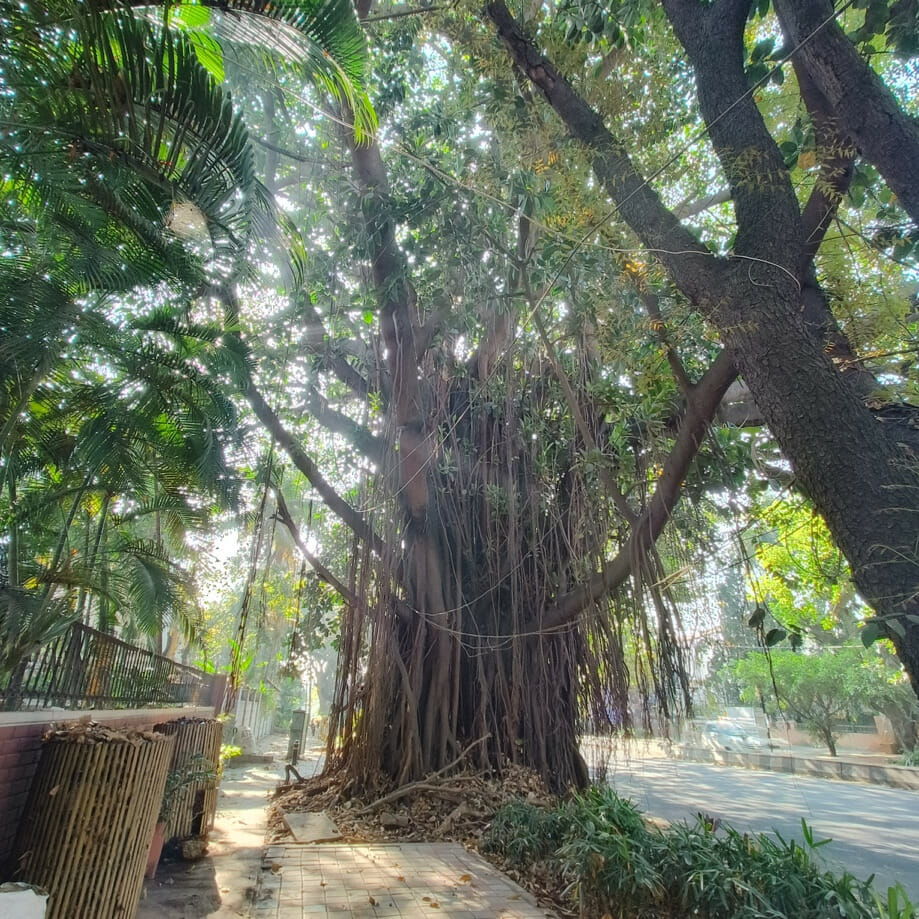
Following protests from citizen groups, the BBMP Commissioner Tushar Giri Nath has put the plan on hold, as of now. However, the final decision still lies with the Bengaluru Metropolitan Land Transport Authority (BMLTA).
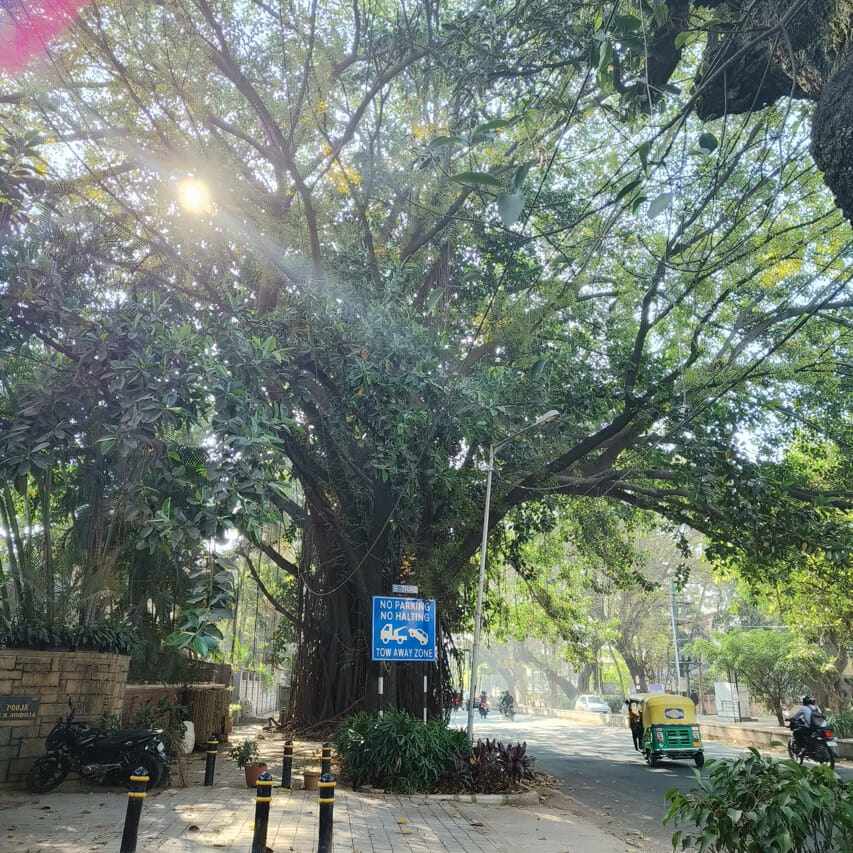
A picturesque tree-lined avenue
According to the DPR, the 600 metre-flyover will extend from the Sankey Tank Gate at Malleshwaram 18th Cross till Cauvery Junction on Bellary Road via Bhashyam Circle. The Sankey Tank Bund Road stretch (T Chowdiah Road), which extends from the gate till Bhashyam Circle, alongside the Sankey Lake, will be widened on the Malleshwaram side by 15 metres.
A lot has been written about the feasibility of the flyover. Neighbourhood groups as well as non-profits like Jhatkaa.org have been vehemently protesting against its construction, deeming it as unnecessary as it is destructive to the grand old trees on the stretch, many of which come under the heritage tree tag, owing to their age, size, and ecological interest.
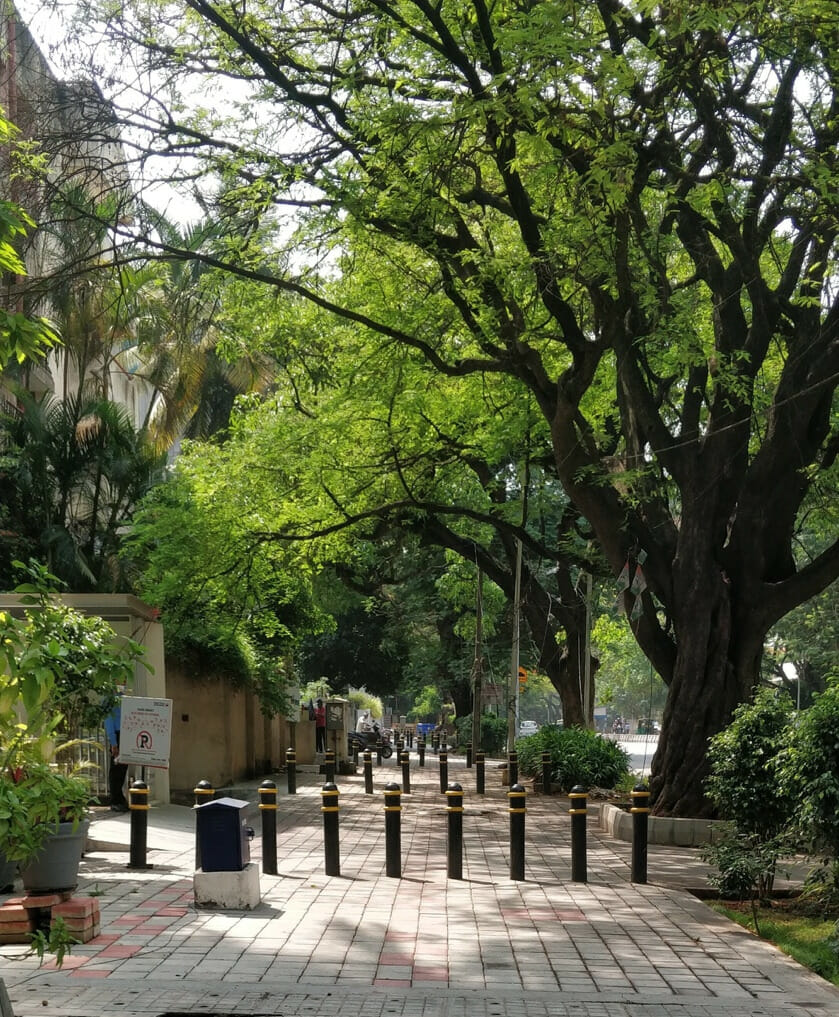
Indeed, the said stretch is probably one of the few picturesque tree-lined avenues left in North Bengaluru, with wide and well-maintained pavements, which are a favourite with dog walkers, where you still hear the chirping of birds in the mornings.
The BBMP has marked several of the trees to be cut as well, which according to them, are only 39. However Harini Nagendra and Seema Mundoli of Azim Premji University (APU) and Vijay Nishanth of Vruksha Foundation have counted 55 trees in this stretch, from 23 species and 14 families, in their report titled ‘Environmental Impacts of proposed flyover on Sankey Road’.
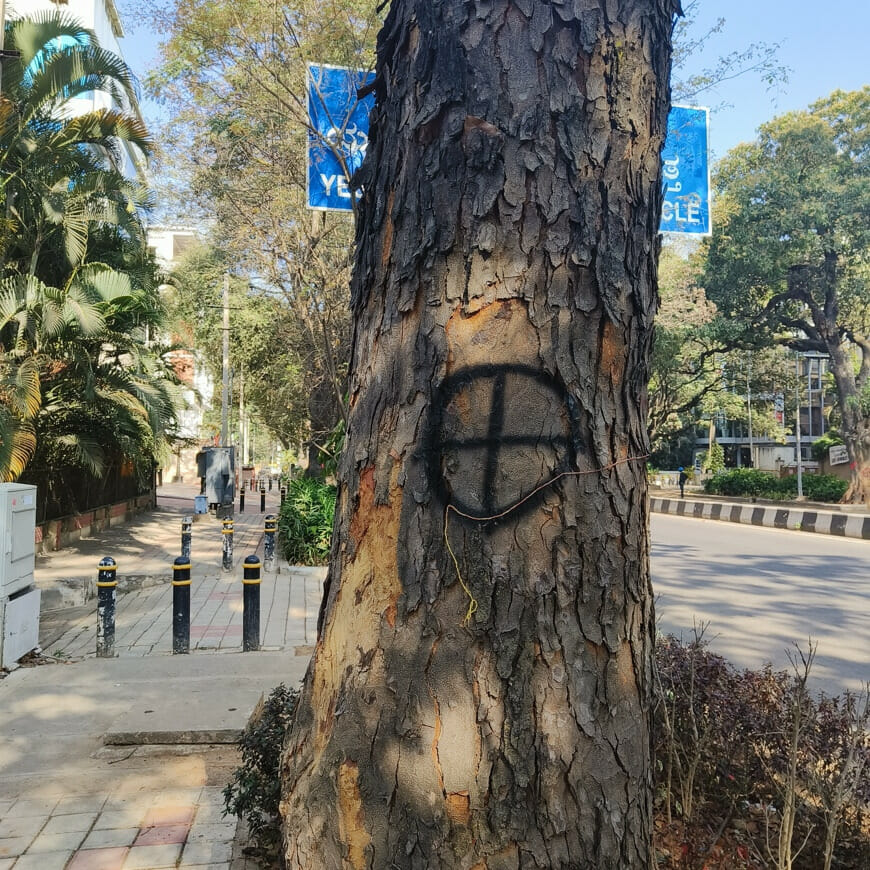
“The DPR has not counted the paper mulberry trees on the sides of the Sankey Tank Bund Road, the trees on the Sankey Lake walkway or in the Stella Maris School Garden at Malleshwaram,” says Seema.
Among the trees identified by the APU team are raintrees, banyans, mahogany, teak and an astounding range of fruit trees like mango, tamarind, java plum, star gooseberry and more, a rarity in the middle of a city.
How did so many fruit trees come up in the middle of a city?
“They are what remain of the orchard of the Bangalore Palace, which is how the area is still known as – Lower and Upper Palace Orchards,” says Pragathi Mathur, a resident of an apartment in Sankey Road. “The entire area is full of fruit trees, and houses have been built around them. All the trees are more than 50 years old,” she says.
The trees in the stretch are habitat to a variety of birds and small mammals, which is a reason replanting could never be a solution. Saplings cannot replace the larger older trees and fruit trees as the type of birds they attract are unique, says Jagdish Krishnaswamy, Dean, School of Environment and Sustainability, Indian Institute for Human Settlements, which is incidentally situated right behind one of the Indian rubber figs.
He has spotted parakeets, the white-cheeked barbet, and the coppersmith barbet besides fruit bats in this area. Birds from nearby areas forage in these trees and vice versa, he says. “You disrupt an entire ecosystem which thrives on it when you cut a tree.”
Read more: Sankey road widening: A project that doesn’t die
“Also, people usually associate migratory birds with waterbodies, but those like the wintering warbler have also been spotted in these trees,” Jagdish says. The APU report mentions black kites (Milvus migrans) having been found on the African tulips, besides evidence of nesting.
Above all, these shade trees contribute immensely to the microclimate regulation in the area, says Jagdish. Expectedly, the stretch remains moderately cool even in the peak of summers.
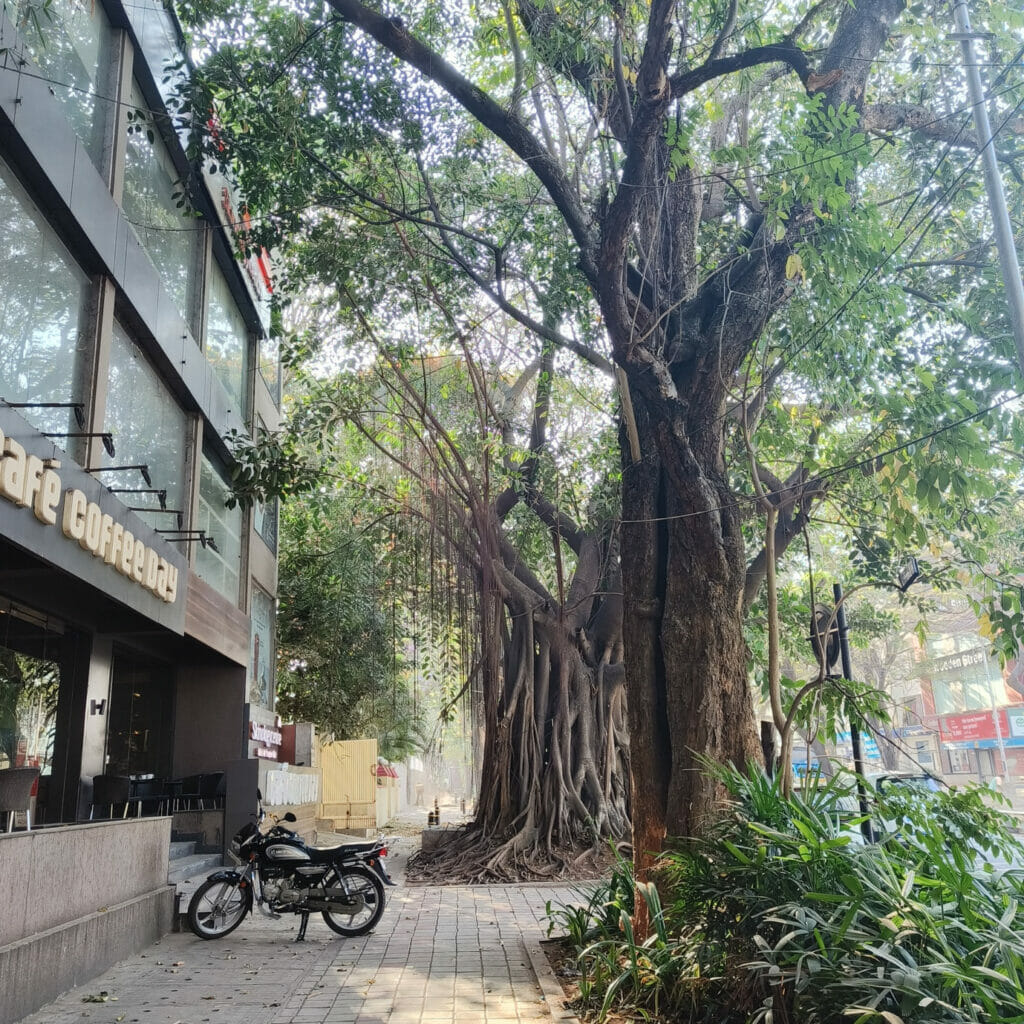
While the pink trumpets, which Bengaluru is slowly getting known for, are indeed great to look at, we also need to protect endemic species of trees as well, says Renuka Pooja, who regularly conducts Tree Walks in the city.
Impact on Sankey Lake
Situated right next to the Sankey Bund Road is the Sankey Lake, which is also expected to be considerably affected in the event of road widening. Constructed in 1882 by Col. Richard Hieram Sankey of the Madras Sappers Regiment, the 37-acre lake has evolved into a popular walking area over the past two decades, frequented by residents of the neighbouring areas of Sadashivanagar, Vyalikaval, Guttahalli, and Malleshwaram.
While the trees located on the walkway may not be cut, there will have to be lopping of the canopy, especially of the rain trees, one of which is massive with a height of around 12 metres, says the APU report.
The report also notes that the proposed flyover violates the 2019 Supreme Court order, which specifies a buffer zone of 30 metres around lakes to protect lake ecosystems from being impacted by land use changes.
The citizen portal e-Bird indicates that 88 species of birds have been spotted in Sankey Lake over the years. But then, the bird species in the area have already started disappearing over the years due to unscientific maintenance of the lake. “The Sankey Tank has great potential for hosting a large number of aquatic and bird species, considering its shape, shoreline vegetation, and water levels,” says Jagdish, adding that something as massive as a flyover coming up next to it would be the death knell for any such possibility.
The APU report also mentions that a range of insect and mammalian species, including the Indian flying fox (Pteropus giganteus) and bonnet macaque (Macaca radiata) have been spotted within a radius of about a kilometre around the proposed flyover, as listed on the citizen science portal—the iNaturalist. Several species of spiders, moths, and butterflies have also been listed, many of which depend on the green foliage as a habitat and for their food.
Citizens protest
An informal survey in the neighbourhood by the group Citizens for Sankey indicates that 92% of residents are against the idea of a flyover. “We have no clue why this project, which was stalled in 2011 due to environmental concerns, had to be picked up again. It’s been proved over and over that the solution to Bengaluru’s traffic bottlenecks, if any, is a large-scale shift to public transport, not flyovers,” says Preeti Sunderajan, a member of Citizens for Sankey.
“This flyover too will only shift the traffic congestion from Bhashyam Circle to Cauvery Junction, besides kicking off possibilities of future flooding.”
The police have been taking down the banners they put up, and arresting members who participate in peaceful protest marches, group members say.
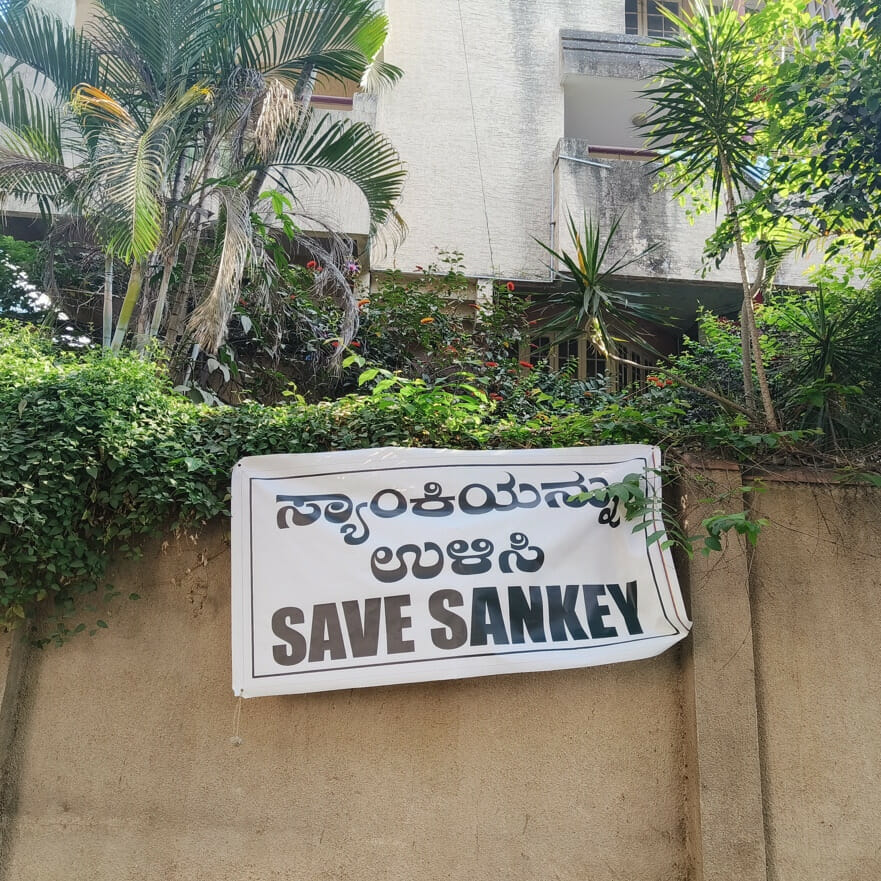
Besides the trees, the buildings which would be demolished on the Malleshwaram side include schools, temples and offices. Nearly 2,000 school children from Stella Maris School, Malleshwaram, recently sent hand-written postcards to Chief Minister Basavaraj Bommai requesting him to protect their school. Ironically, one of the temples near the 18th Cross worships the peepul tree in its compound.
Read more: In photos: Age-old trees felled for Bellary road widening
Sharath Krishnamurthy, also a member of the group, recalls that an entire row of trees on the stretch towards Malleshwaram 18th Cross from Bhashyam Circle was cut overnight by civic bodies without warning in 2011, though the widening was stalled later. He fears this will happen again, this time in Sankey Road. Citizens for Sankey recently held a poster protest on March 4th. Every building in the area hung posters saying ‘Save Sankey’.
While it is true that a large part of the Palace Orchards, which was once a fruit forest, was sacrificed to develop the current Sadashivanagar, the situation is vastly different now with climate change catching up on us, says Pragathi, countering the argument. “The need to retain the remaining trees is higher than ever.”
As Jagdish says, “You need better infrastructure but green infrastructure is equally important. And the trees are part of it. You cannot sacrifice one for the other.”
List of tree species to be cut/impacted if the Sankey Road Flyover comes up:
- Indian rubber fig (Ficus elastica) – 2
- Rain tree (Samanea saman) -2
- Silver oak (Grevillea robusta) -2
- Copperpod (Peltophorum pterocarpum) – 7
- African tulip (Spathodea campanulata) – 6
- Indian beech (Millettia pinnata) – 2
- Indian cork (Millingtonia hortensis) -1
- Cluster fig (Ficus racemosa) -1
- Banyan (Ficus benghalensis) -1
- Malabar neem (Melia dubia) -2
- Eucalyptus (Eucalyptus sp.) -1
- Teak (Tectona grandis) -1
- Gulmohar (Delonix regia) – 2
- Portia tree (Thespesia populnea) -1
- Indian almond (Terminalia catappa) -1
- Devils tree (Alstonia scholaris) -1
- Mahogany (Swietenia macrophylla) – 4
Fruit trees:
- Mango (Mangifera indica) – 6
- Tamarind (Tamarindus indica) -2
- Jackfruit (Artocarpus heterophyllus) – 3
- Butterfruit (Persea americana), – 3
- Coconut (Cocos nucifera), -2
- Cucumber trees (Averrhoa bilimbi) -2
- Pond apple (Annona glabra) -1
- Star gooseberry (Phyllanthus acidus) – 1
- Sapodilla (Manilkara zapota) -1
- Java plum (Syzygium cumini) -2
- Source: Azim Premji University
No no and we citizens are very
City has grown and others outside city opting Bangalore.